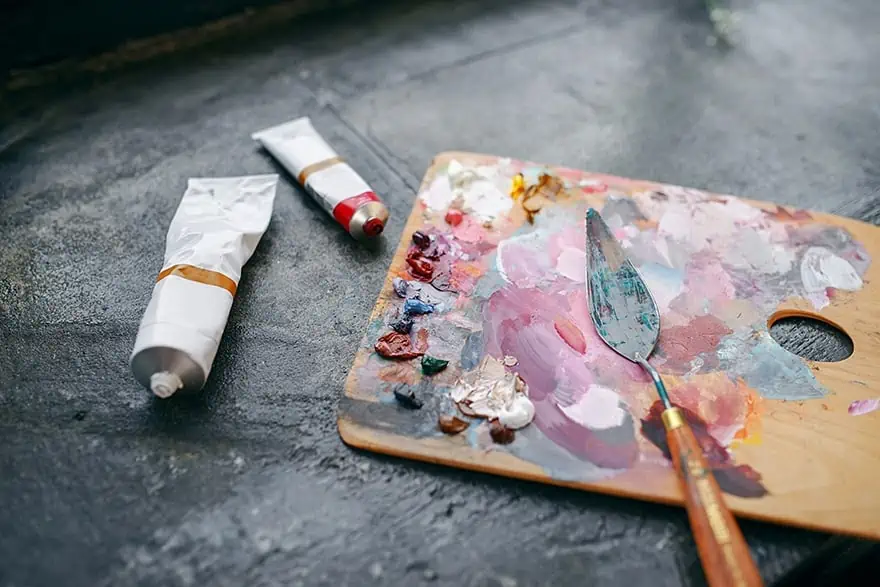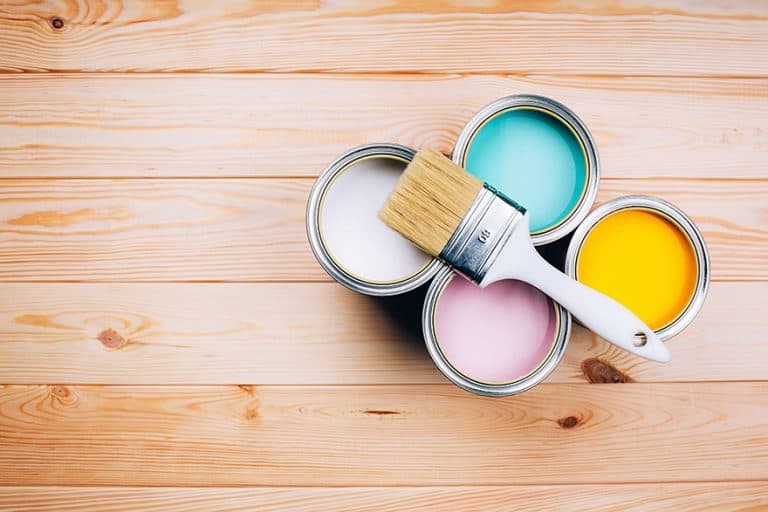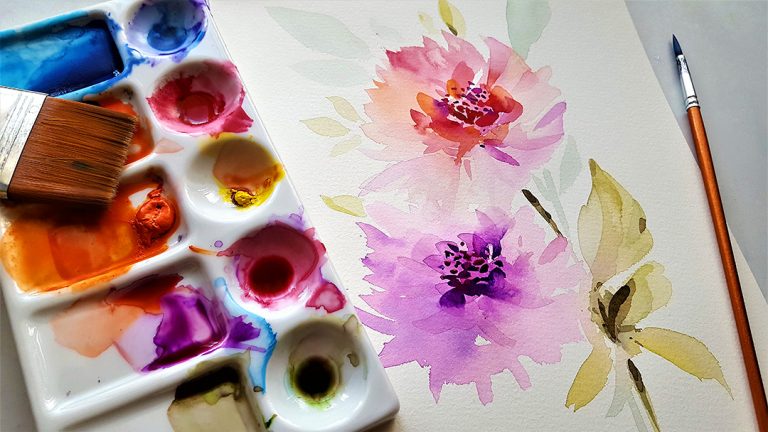How to Make Oil Paint Dry Faster – All about Oil Paint Drying Times
This post may contain affiliate links. We may earn a small commission from purchases made through them, at no additional cost to you.
An oil paint’s main feature is its ability to dry slowly, so there is no such thing as fast drying oil paint. This feature is what attracts many artists as you have plenty of time to work before it becomes dry. However, certain factors can affect the drying time of paint and when it comes to how to make oil paint dry faster, there are a few methods you can use. Below, we will be taking a closer look at oil paint drying times and discovering how to dry oil paint fast.
Table of Contents
Factors That Affect Oil Paint Drying Times
The faster drying paints would include your watercolors and acrylics and these dry through a process of evaporation. Oil paints, on the other hand, dries much slower by the process of oxidation. The oxidation process is similar in apples or avocados, where you will notice the flesh of the food item turning brown. Thankfully, oil paints do not turn brown, but the oxidation process is what slowly dries and hardens oil paints.
Oil paint drying times are not the same due to many factors including the brand, climate, and other factors we will be dealing with below. An oil painting can take anywhere from 8 hours to a few days to dry to the touch and months to dry properly. So, let us have a look at these factors and why they have an effect on oil paint drying times.

The Thickness of Paint Layers
How thick you apply the oil paints will determine how long the paint takes to dry. A thicker layer will naturally take longer than if you used a thinner layer. Some painting techniques use heavier paint layers, for example, impasto which might need as long as a week to dry to the touch. Using a wet-on-wet or alla prima technique might produce quicker results.
Oils Used in the Paint
The drying time can be influenced by the oil used in oil paints. For example, linseed oil will dry in about two days, while safflower can take three days or longer to dry to the touch. Poppyseed oil takes even longer to dry than all of these options. Linseed is the most commonly used oil as it is the fastest drying.
Oil Paint Brand
Oil paints have varying drying times when it comes to different brands. The reason being that each brand or manufacturer uses its own formula and ingredients. Many of the better quality oil paints contain more pigment and binder, and fewer or no additives which reduce the quality of the paint. The more “pure” the oil paint is, the better its appearance and the way it handles.
Paint Pigment
Different color pigments also tend to have varying drying times, as the structure of certain pigments is heavier than others. The earth-toned colors, for example, brown and orange, and paints that contain iron oxide, all tend to dry quicker than other paints. Some faster drying color examples include:
- Raw Sienna
- Burnt Sienna
- Burnt Umber
- Cobalt Colors
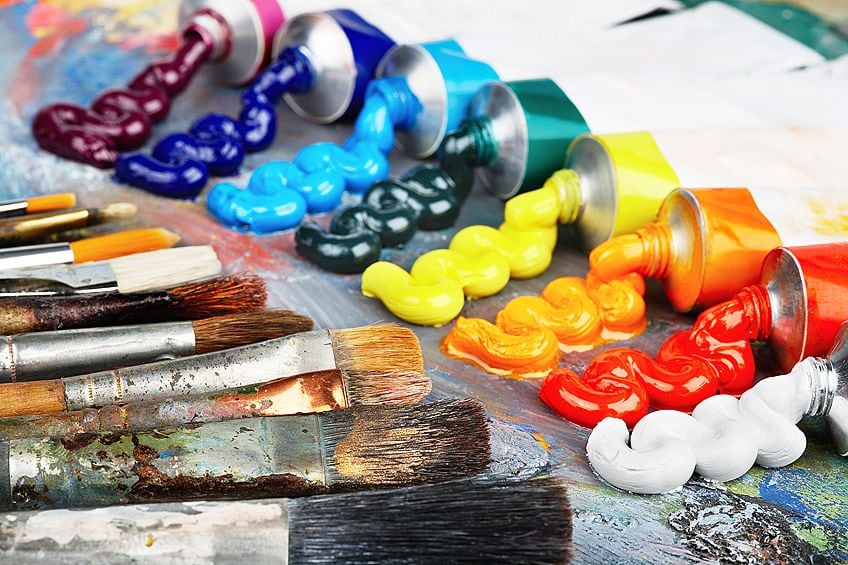
Then you have your color pigments that tend to dry more slowly than the rest. These specifically include your white, black, reds, yellows, and cadmium colors. The faster drying colors should dry in about two days, while others can take anything from five days or longer. Other ingredients in the paint besides the pigment can also affect drying times, things like oil paint mediums and additives.
Painting Environment
First, the temperature will affect the drying time, where a warmer climate will speed up drying time and colder environments will slow the drying process down. Also, if it is humid, this will slow the drying time down as there is a lot more moisture in the air. Painting outside, where there is a slight breeze or wind can help to speed up the drying process. The ideal weather outside should also be dry, sunny, and warm.
Painting Surface
The type of surface you use can also affect the paint’s drying time. Painting on an absorbent surface, some of the paint will be absorbed, which can help to reduce the drying time. When painting on a less absorbent surface, and a surface that has been primed, the paint will take longer to dry.

Age of the Paint
The drying time of paint can also be affected by the age of the paint in the tube. Maybe the paint tube has been sitting on the shelf for a while and the seal has been broken or the container is damaged in some way. The oxidation process would have already begun, and the paint will start to harden before you have even used it.
How to Dry Oil Paint Fast?
Now that you understand some of the factors that influence the drying time of oil paints, you can figure out how to make oil paints dry faster. Layering oil paints can be a waiting game unless you want to blend or apply a wet-on-wet technique. There are many ways you can help with the paint drying time. However, you should take note that this drying time is about “drying to the touch” and the actual curing time or proper drying time can take months if not years for some art pieces. Here are a few methods you can try on how to dry oil paint fast.

The Best Place to Paint
We already know that your environment can play a big part in affecting paint drying times. You can improve drying times by simply working in a dry area where there is effective air circulation. The room should also be warm, so a lot of natural light will help. You can try using a fan to create more air circulation, or simply open a window. When using a fan, also be aware of dust, make sure the fan is clean as you do not want added dust particles flying around. A dehumidifier can also improve the drying time.
Heating the Oil Paints
You can expose your painting to heat, which can improve drying times. A good way is to simply place in a warm space with enough natural light. You can alter the thermostat to create a warmer environment inside. Some have even tried using a heat gun to speed up the drying time. However, this might cause other problems because if you use the heat gun at a too high temperature, you run the risk of the paint cracking and yellowing over time. When using the gun, keep the temperature under 130 degrees Fahrenheit and move over the painting slowly, holding the gun at least seven inches away from the surface at an angle. You can also try a hairdryer; the same method applies as with a heat gun. A safer way to apply the heat is from the back of the canvas. This way the layers of paint dry from the bottom up and you do not expose the top layers to the intense heat.
Applying Thinner Layers of Paint
Thick paint layers will take longer to dry than if you use thin layers. This works well with the “fat over lean” idea. To create depth, multiple layers are usually added, and applying a thin layer first, will dry faster and help subsequent layers to also dry more quickly. The concept of “fat over lean” is a method you should follow to avoid the paint from cracking and other problems that can occur when it dries. You can start with the thinnest layer at the bottom of your painting, and you can add a thicker layer as you go. To thin the oil paints, you can use solvents, for example, mineral spirits or turpentine.
These solvents produce toxic fumes, which can be harmful if you breathe them in, so you should use them with care. There are also odorless solvents available as well as non-toxic options that are specifically made for this purpose. For example, you can consider using Spike Lavender oil, or a citrus-based medium.

You can also thin oil paint with oils, however, this might slow down the drying time instead of speeding it up. As mentioned above, some oils do dry quicker than others. For fast-drying oil paint, stick to linseed oil and try to avoid poppy oil, walnut, and safflower oil if you want your paint to dry faster. When applying a thinner base layer of paint, you can also consider using a paint color pigment that dries faster than others.
How to Use Solvents
Place some solvent in a small jar that can be properly sealed to prevent any fumes from escaping. The smaller container is also best as you might get some paint mixed in and a small amount is easier to discard and replace with fresh solvent. You can dip a paintbrush into the solvent, you can dip only the tip or the entire brush depending on what consistency paint you are looking for. The more solvent you use, the thinner the paint will become. Mix the solvent into your paint on the palette, then apply to the canvas. You can also place a few drops of solvent onto the paint and mix on your palette if you have a larger amount of paint to thin.
Drying Mediums
How to dry oil paint overnight? You can use alkyd paint, which is designed to dry almost overnight and can be used as a substitute for traditional oil paints. Drying mediums can be added to oil paints to increase drying times. These drying mediums can be added in small amounts to the paint before you apply it to the canvas. Thinner applications of paint can begin drying in about an hour, while thicker consistencies can take around several days. You might find that some products produce varying drying times, so always read the product instructions and label before purchasing.
These products usually give the paint a glossy look and have to be used carefully as they can be toxic. The two best-known drying mediums include Galkyd which is manufactured by Gamblin, and Liquin, which is from Winsor & Newton. You can also get a Walnut Alkyd made by M. Graham which is a non-toxic option. When using these drying agents, it is advisable to wash your brushes after you are done using the product.
Acrylic Paint as a Base Layer
The process of painting can involve many layers of paint, each one taking some time to dry before being able to add the next layer. So, instead of using oil paint for the initial layer, you can use acrylic paint. The acrylic paint can be applied and forms the basis of your colors and color values. Easy to apply and it dries quickly. This method sticks to the rule of “fat over lean” as it is a thin layer of paint to which you can build your subsequent oil paint layers.

Applying a Primer Layer
When using a primer, it provides a more porous surface to work from and helps the paint adhere better to the surface. A primer like gesso can also help to improve coverage and increase the durability of the canvas. You can apply at least three coats of primer when it comes to oil paints. Gesso comes as a traditional gesso, or you can get an acrylic gesso. The glue chalk gesso would be a better option. There are also other surfaces you can try for increasing drying times, for example, lead-primed linen and alkyd-primed surfaces.
Painting a Flat Surface
A rough surface can take more paint and will take longer to dry. Painting a flat surface helps to spread the paint out evenly and will dry faster. Applying layers when painting is also easier when it is done on a flat surface.
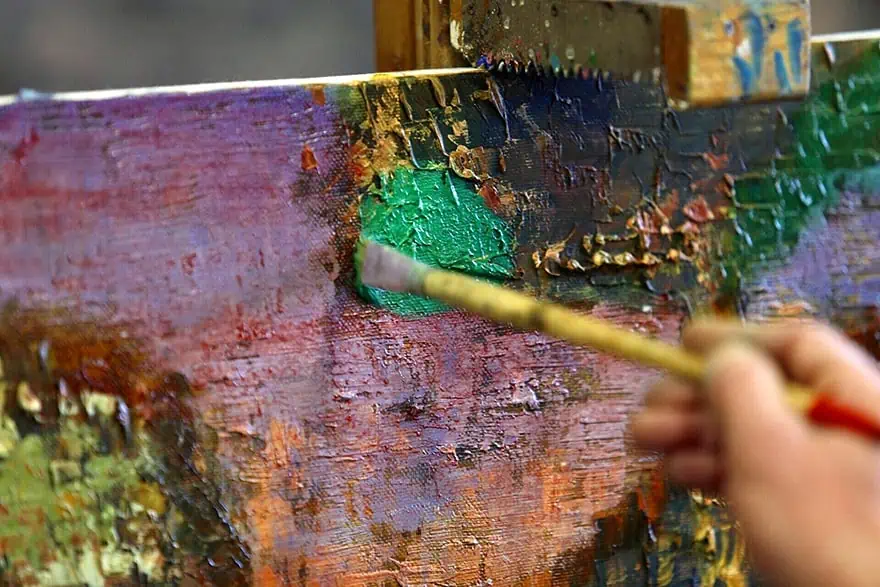
Mistakes to Avoid
Now that we have covered a few points on how to make oil paints dry faster, there are a few things you should be aware of. Some mistakes can be made which might negatively affect the oil painting over time.
- Placing an oil painting in sunlight for short periods, for example, painting outside or to dry should be okay. However, avoid placing in direct sunlight or close to heat for extended periods as this will affect the pigments, and the colors will change and will ultimately damage the painting
- Leaving a painting outside can be risky, due to dust and other items that could land up on the painting
- Using a heat gun or hair dryer can dry the paint faster, but it may also provide an intense heat that can eventually cause the paint to crack.
- Some have baked their paintings in the oven or sprayed with hairspray. Again, you run the risk of the paint eventually cracking. The best option is to be patient when it comes to using oil paints
Oil Paint Drying Time Comparison Table
Taking all of the above, we thought creating a small table will help you to compare all the methods used to increase oil paint drying times. Some methods you can easily do without purchasing any special products, however, there are quite a few options available. Remember, exposing oil painting to heat and using other methods will only increase the initial drying time, in other words, it will become dry to the touch. A painting could take a long time to dry, months or even years. The below drying times are rough estimates, as the results are dependent on many things, such as the techniques used, paint pigments, surface, and other variables. So, your painting could, therefore, take anything from 24 hours to a couple of days to dry. The cost of products also depends on the brand and how much you buy.
| Cost | Estimated Drying Time | Toxic | |
| Environment | Free | Direct sunlight, only for a few hours. Preferably in a warm, dry, well-ventilated space for at least two days | ✘ |
| Heating the Oil Paints (not recommended) | Cost of electricity or purchasing a heat gun | You need at least 4 hours at a certain temperature, so not very practical | ✘ |
| Thinners and Solvents (artist quality) | |||
| Turpentine | Affordable | 24 to 48 hours | ✔ |
| Mineral Spirits | Affordable | 24 to 48 hours | ✔ |
| Spike Lavender | Affordable | 24 to 48 hours | ✘ |
| Drying Mediums | |||
| Galkyd | Expensive | 24 hours | ✔ |
| Liquin | Expensive | 24 to 48 hours | ✔ |
| Walnut Alkyd | Expensive | 24 to 48 hours | ✘ |
How to Determine if the Oil Paint is Dry
Sometimes, it can be hard to see if an oil painting has dried thoroughly. There is a method whereby you can test your painting if you are unsure. Remember, something that is dry to the touch does not mean it is completely dry or cured. The method to check is fairly simple, you can either use a razor blade or your nail. Make sure to apply light pressure to scrape a small area of paint on the surface. The paint should have a powdery consistency if it is dry. However, if you notice some paint comes away in a thread, it is still wet. Wait another week if it is still wet and repeat the test. You do not want to damage the painting, so make sure you apply pressure gently.
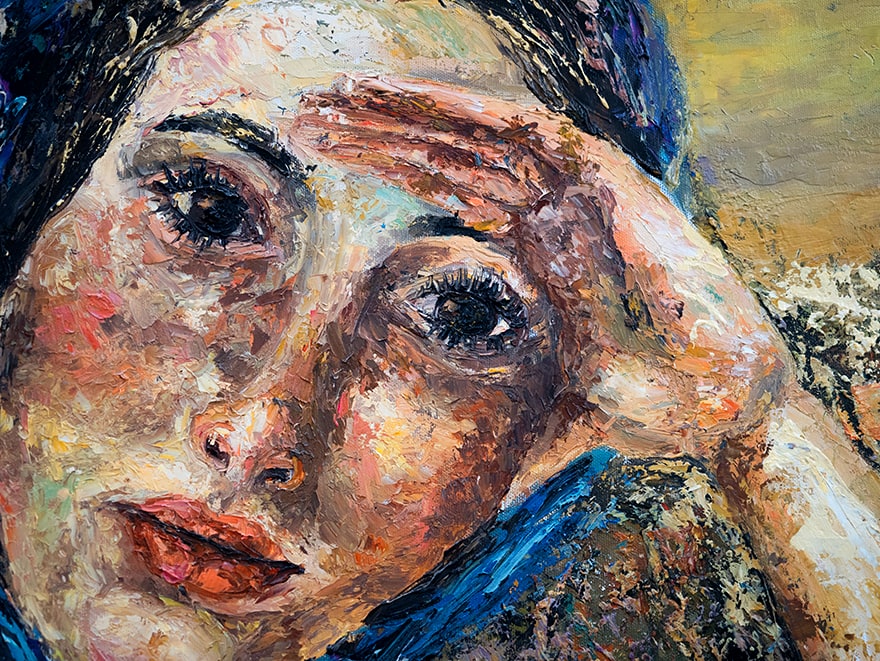
Frequently Asked Questions
Does an Oil Painting Take Long to Dry?
Oil paints dry through a chemical process known as oxidation, which can take a long time. Many oil paintings are also done in layers, so the paint will slowly dry from the top layer down to the bottom layer. Drying to the touch can take from 24 hours up to a few days, however, drying thoroughly can take months.
Will An Acrylic Paint Base Work With Oil Paints?
Yes, the whole painting process can be done quicker if an acrylic paint base is applied. The acrylic paint dries faster than if you applied an oil paint base.
How to Dry Oil Paint Overnight?
Alkyd paints dry quickly, in about a day, and can be used as an alternative to the traditional oil paints. You can also combine both of these paints. The alkyd paints have a similar consistency and can easily be worked on the canvas. These paints are also less expensive than some of the more traditional oil paints. You can also consider adding drying mediums to your traditional paints.
Is It Possible to Dry Oil Paints Using a Hairdryer?
Since oil paints naturally dry slowly through an oxidation process, applying heat is not the best method to speed up the drying process. Even if it did help with drying, you would need to hold it over the painting for quite some time. Applying intense heat can also damage the painting, causing it to crack in time. A painting is best left in a dry, warm environment with good ventilation. If you are looking for fast-drying paint, consider acrylic paints instead.
How to Make Oil Paint Dry Faster?
There are many ways to improve oil paint drying times. You can start by painting in a warm, dry environment with good ventilation. Other methods include adding a drying medium or thinning the paint with solvents like turpentine. The type of pigment you use can also affect the drying time. Ultimately, oil paints dry slowly, and patience is needed if you want the best results.
In 2005, Charlene completed her wellness degrees in therapeutic aromatherapy and reflexology at the International School of Reflexology and Meridian Therapy. She worked for a company offering corporate wellness programs for several years before opening her own therapy practice. In 2015, she was asked by a digital marketer friend to join her company as a content creator, and it was here that she discovered her enthusiasm for writing. Since entering the world of content creation, she has gained a lot of experience over the years writing about various topics such as beauty, health, wellness, travel, crafting, and much more. Due to various circumstances, she had to give up her therapy practice and now works as a freelance writer. Since she is a very creative person and as a balance to writing likes to be active in various areas of art and crafts, the activity at acrylgiessen.com is perfect for her to contribute their knowledge and experience in various creative topics.
Learn more about Charlene Lewis and about us.
